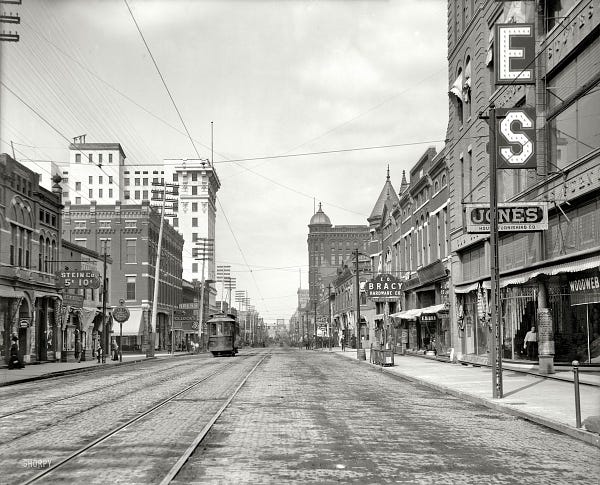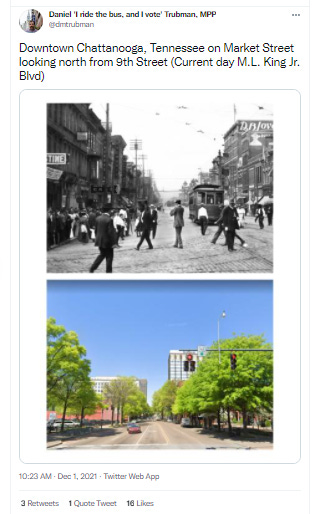A Hint of America's Lost Urban History
A before-and-after picture is worth a thousand urbanist words
Take a look at these two tweets from a couple of months ago:





One more (it’s a screenshot because the preview cuts off the bottom photo):
If you’re on Twitter, follow these folks for more like this.
In response to the second one here, of the unidentified southern city, I tweeted: “This strikes me as possibly the most forgotten and untold aspect of American history.”
The first time I saw one of these I was stunned. I’ve now seen dozens of before-and-after photo sets of destroyed downtowns, or simply old photos of streets that are unrecognizable today. And yet growing up as an average American kid, I never learned anything that would suggest America’s anti-urban sentiment is a relatively recent phenomenon, or that Americans of all religious and political stripes, all across the country, in large and small settlements, lived in towns and cities that looked like this.
In some ways, of course, it’s not a recent phenomenon. Thomas Jefferson thought cities were dens of iniquity and wanted everyone to be a small farmer, after all. This streak of thinking was there from the beginning. Yet even so, the average American settlement up until the 20th century looks today incredibly urban.
It’s a sort of truism in political commentary that both parties treat the 1950s as a “normal” baseline—Republicans for its cohesion and social conservatism, the Democrats for its strong unions and relatively equal distribution of wealth. At a broader level, much of our conception of the built environment, and what constitutes a “good” place to live, is also stuck in the 1950s, when the postwar boom supercharged what was already a slow shift to suburban land-use patterns.
Even most of the popular (i.e. non-academic) books on this subject fail to convey just how drastically American towns and cities changed as the car and the concerns of commuters took precedence. Yes, the reasons for all of this are complex. General Motors didn’t buy up the streetcars so they could rip them out. We did this to ourselves in many ways, and at the time it felt like progress.
And to be fair, America’s old cities wouldn’t be everyone’s cup of tea. Perhaps it’s easier to appreciate these erstwhile rough-and-tumble landscapes from afar, just as you can read Little House on the Prairie and daydream about being a pioneer.
But still. My point here isn’t the nitty-gritty of land-use policy, but simply that once this existed everywhere in America. Just knowing that can change how you see everything. Almost everybody today thinks of “Anywhere, USA” as a Walmart and a McDonalds on a highway. I never realized just how historically illiterate that is—whether you love or hate Walmart or McDonalds or highways.
Related Reading:
Please consider upgrading to a paid subscription to help support this newsletter. You’ll get a weekend subscribers-only post, plus full access to the archive of over 200 posts and growing. And you’ll help ensure more material like this!




